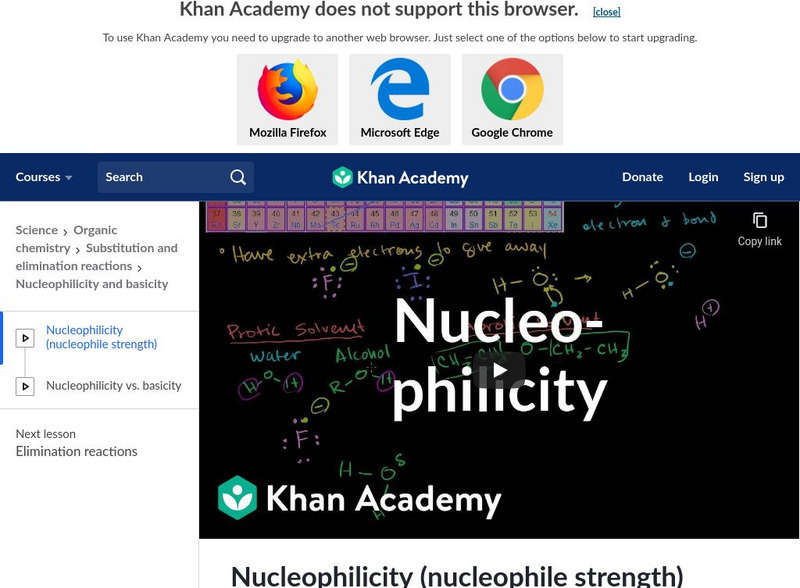Professor Dave Explains
Organometallic Reactions Part 5: Nucleophilic/Electrophilic Attack on Ligands
Reactions that occur on the ligands themselves are quite common. Let's look at two common types of ligand reactions: nucleophilic and electrophilic attacks. Which types of ligands that are susceptible to these attacks and what happens?
msvgo
Preparation of Alcohols
It explains various methods for preparation of alcohols and phenols and the chemical properties and reactions of alcohols and phenols.
Professor Dave Explains
Nucleophiles, Electrophiles, Leaving Groups, and the SN2 Reaction
Defining nucleophiles, electrophiles, and leaving groups, and introducing the SN2 reaction.
Professor Dave Explains
Gabriel Amine Synthesis
It's time to learn some name reactions! We've seen a lot of these already, but now we are going to hit several dozen more. First up, the Gabriel synthesis of primary amines. This is an old one, from 1887. Let's check out some old school...
Professor Dave Explains
Nucleophilic Aromatic Substitution
An introduction to nucleophilic aromatic substitution.
Khan Academy
Nucleophilicity (Nucleophile Strength)
Sal explains the details that affect nucleophile strength. He gives examples of electronegativity producing a fluorine anion, iodine becoming iodide, and a molecule such as the hydroxide ion. He compares their polarity, basicity, and...
Khan Academy
Comparing E2 E1 Sn2 Sn1 Reactions
Sal presents certain mixtures of solvents and ions and runs through the factors that determine which reactions might occur in those contexts. This is an excellent review of not only the specifics of each reaction but also the real-life...
Khan Academy
Ring-Opening SN2 Reaction of Epoxides
Your class should understand the processes Sal discusses here. He recaps the SN2 reaction by removing the oxygen from an epoxide.
Khan Academy
Amine in Sn2 Part 2
An advanced chemistry class will understand Sal's reaction and see his logic in explaining the equilibrium. The levels of electronegativity and likelihood of a nucleophilic attack are balanced and presented in the equation. This is an...
Khan Academy
Sn2 Stereochemistry
A short video introduces class members to Sn1 and Sn2 reactions. The study of the stereochemistry of the end product ensures that young chemists can learn not only about the reaction, but can also review the handedness,...
Khan Academy
Khan Academy: Substitution and Elimination Reactions: Nucleophilicity
A video exploring the definition of nucleophilicity. Learn that nucleophilicity is the ability of an atom, ion, or molecule to lose their extra electron and bond. Also the video explains how to find the strength of the nucleophile. [13:54]
Khan Academy
Khan Academy: Amines in Reactions: Amine in Sn2 Part 2
Video lecture shows how Amine continues to act as nucleophile to generate more products. [10:22]
Khan Academy
Khan Academy: Sn1 vs Sn2: Sn2 Reactions
A video lecture explaining a substitution nucleophilic (Sn2) reaction. [11:31]
Khan Academy
Khan Academy: Electrophilic Aromatic Substitution: Halogenation
Explains what happens during the halogenation of benzene. [8:40]
Khan Academy
Khan Academy: Nucleophilicity and Basicity: Nucleophilicity vs. Basicity
Nucleophilicity vs. Basicity. The difference between what it means to be a nucleophile and a base. [12:48]
Khan Academy
Khan Academy: Ring Opening Reactions of Epoxides: Strong Nucleophiles
Observe the formulae for chemical reactions and bonding utilizing strong nucleophiles. [14:07]
Khan Academy
Khan Academy: Sn1 and Sn2: Nucleophile/electrophile and the Schwartz Rules
Video lecture explores Nucleophile/Electrophile and the Schwartz Rules. [9:26]
Khan Academy
Khan Academy: Acid and Base Catalyzed Hydrolysis of Amides
This video explains the mechanisms for acid and base-catalyzed hydrolysis of amides. [11:46]
Khan Academy
Khan Academy: Acid Catalyzed Ester Hydrolysis
This video explains the mechanism for the acid-catalyzed hydrolysis of esters (and transesterification). [11:25]














